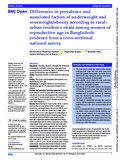Differences in prevalence and associated factors of underweight and overweight/obesity according to rural–urban residence strata among women of reproductive age in Bangladesh: Evidence from a cross-sectional national survey
Citation
Hashan, M. R., Das Gupta, R., Day, B., & Al Kibria, G. M. (2020). Differences in prevalence and associated factors of underweight and overweight/obesity according to rural-urban residence strata among women of reproductive age in Bangladesh: Evidence from a cross-sectional national survey. BMJ Open, 10(2) doi:10.1136/bmjopen-2019-034321Abstract
Objectives This study aimed to investigate the differences in prevalence and factors influencing underweight and overweight/obesity stratified by region of residence among women of reproductive age in Bangladesh.
Design Secondary analysis of cross-sectional nationwide data.
Setting This study used Bangladesh Demographic and Health Survey 2014 data.
Participants A weighted sample of 16 478 women of reproductive age (15–49 years) were included in the analysis.
Primary and secondary outcome measures Using the Asian-specific cut-off for body mass index, the primary outcome of this study was categorised as: underweight (<18.5 kg/m2), normal weight (18.5 to <23.0) kg/m2 and overweight/obese (≥23.0 kg/m2) stratified according to rural–urban residence.
Results More than half of urban women (53%, n=2493) and one-third of rural women (33%, n=3968) were found to be overweight/obese. Around one-fifth of rural women (21%, n=2490) and almost one in eight urban women (12%, n=571) were reported as underweight. In the final multivariable analyses, increasing age, higher educational status and higher order wealth quintile, each had a significant positive association with being overweight/obese and an inverse association with being underweight. Urban unmarried women had lower odds of being overweight/obese compared with their married counterparts. Rural women who used contraceptives had significantly decreased odds (adjusted OR (AOR) 0.8, 95% CI 0.7 to 0.9) of being underweight compared with contraceptive non-users; no such association was noted in urban women. Women from Sylhet division in both urban (AOR 1.7, 95% CI 1.2 to 2.5) and rural regions (AOR 1.5, 95% CI 1.2 to 1.8) had increased odds of being underweight compared with women in Barisal division.
Conclusions This study found association of multiple factors with both overweight/obesity and underweight among Bangladeshi women of reproductive age. Public health programmes in Bangladesh aiming to prevent the double burden of malnutrition should focus these factors through comprehensive public awareness and cost-effective operational health interventions.

